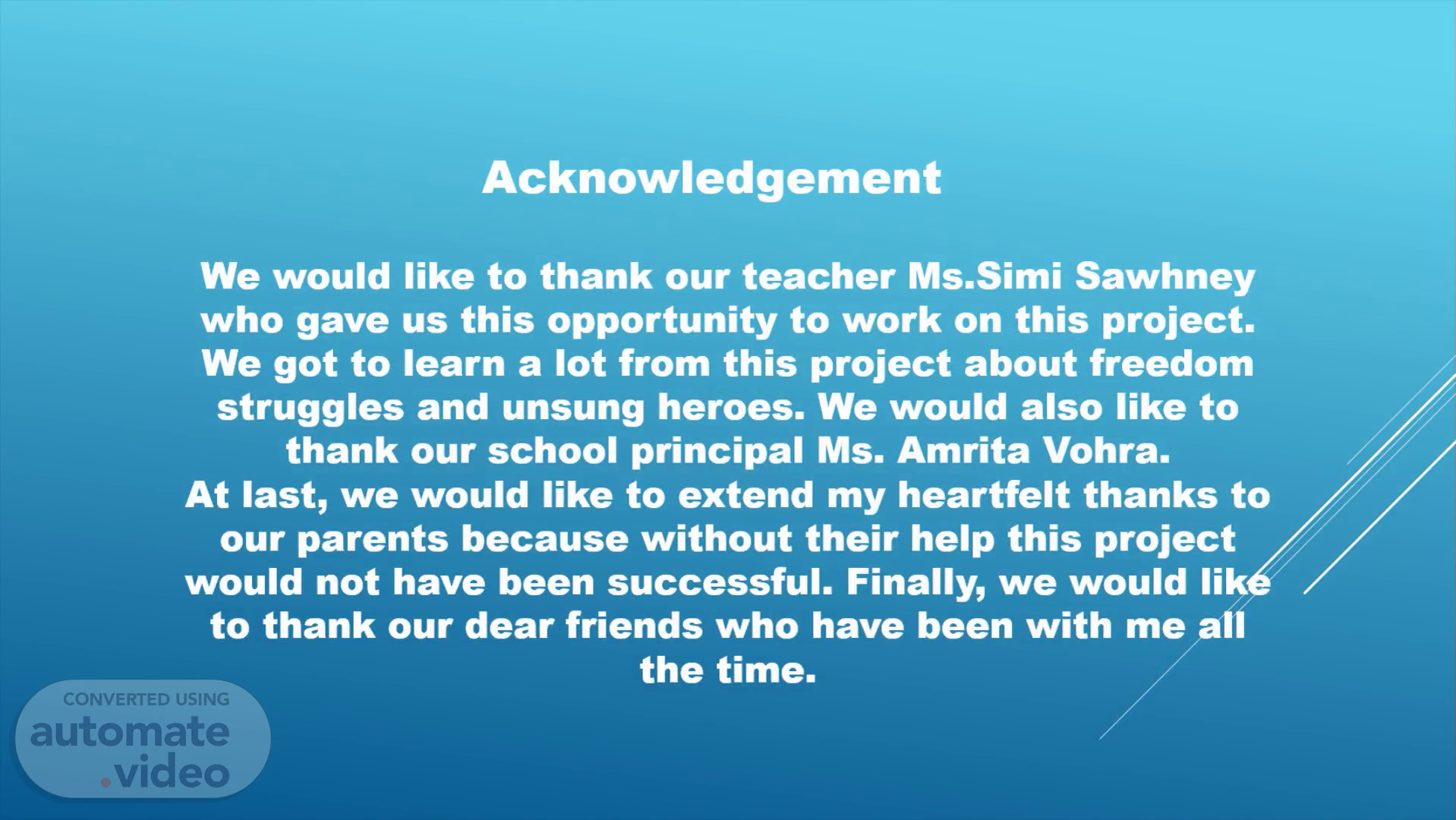
PowerPoint Presentation
Scene 1 (0s)
Acknowledgement We would like to thank our teacher Ms.Simi Sawhney who gave us this opportunity to work on this project. We got to learn a lot from this project about freedom struggles and unsung heroes. We would also like to thank our school principal Ms. Amrita Vohra. At last, we would like to extend my heartfelt thanks to our parents because without their help this project would not have been successful. Finally, we would like to thank our dear friends who have been with me all the time..
Scene 2 (25s)
S.NO PARTICULARS SLIDE NO. 1 Introduction 2 Qualities of Mahatma Gandhi 3 Moral Message of the lesson 4 Central idea of the lesson 5 Unsung Heroes 6 Matangini Hazara 7 Tirupur Kumaran 8 Bhikaiji Cama 9 The three Comardes 10 Conclusion.
Scene 3 (38s)
"You must be the change you wish to be in the world." CREATED USING 4 POWTOOn.
Scene 4 (46s)
The of i 'INDIGO' itle 'Indigo' focuses ur attention on the issue of exploitatioo. igo sharecroppers by bands of cruel British planters. The ugh a long-term agreeynent td plant n9igo on i5percent harvest Hent.iÅfter synthetlcindigobyfermanyßh< Britisméjahgersextracte&money from th? peasants as compensationfor.being release@fionuhe 15 p rcent,agreement. The peasants who wanted their money suit't Rajkumar Shukla persuaded Gandhi to take upthe case oflndlgo sharecroppersso indigo sharecropping exemplifies the injustice of— the British and the Indians' submission to British authority. The Champaran movement that centered on indigo sharecroppin led to the social and cultural upliftment of the peasant CREATED USING 4 POWTOOn.
Scene 5 (1m 10s)
Qualities of 1. Appreciates loyalty/commitment. 2. Understands the issue e.g., meets Kriplani/lawyers/peasants. 3. Connect with masses. 4. Organised several movements e.g., civil disobedience, etc 5. Fairleader e.g. won lawyers' support. 6. Visionary e.g., improves social, the cultural backwardness of Champaran CREATED USING 4 POWTOOn.
Scene 6 (1m 33s)
MORAL MESSAGE OF THE LESSON - The story 'Indigothighlights the unequal —economic systepp that existed during colonial British rule. Itxesulted in Indian peasants— suffering,ÅMhiIe the Brjtish planters exploited them. IC also highlights the importance of Gandhi's decision to take up their case, w ich exposed the unjust system CREATED USING 4 POWTOOn.
Scene 7 (1m 53s)
The leadership is shown by Mahatma Gandhi to secure justice for oppressed people through convincing argumentation and negotiation. The chapter 'Indigo' emphasizes the fact that effective leadership can solve any kind of problems without any harm to anybody. This chapter deals with the way Mahatma Gandhi solved the problem of poor sharecroppers of Champaran in a non-violent way CREATED USING 4 POWTOOn.
Scene 8 (2m 28s)
UNSUNG Heroes: Despite their incredible contribution towards an independent India, many freedom fighters were never acknowledged for their brave efforts Focusing on the contribution of these Unsung Heroes for the work they did behind the 4 scenes and the efforts that went unrecognized and unappreciated, we want to talk about some of the heroes. CREATED USING POWTOOn.
Scene 9 (2m 51s)
Matangini Hazara CREATED USING 4 POWTOOn.
Scene 10 (2m 58s)
1905, Hazra became actively interested in the independence movement. In 1932, she took part in the Civil Disobedience Movement and was arrested for participating in the Dandi March led by Mahatma Gandhi and breaking the Salt Act. British officials had introduced taxation on salt production, and so the walk to Dandi to make sea-salt was considered illegal. This caused resentment among people as it was the local practice in Dandi to produce salt from seawater. Hazra was imprisoned for six months in Baharampur. CIVIL DISOBEDIENCE MOVEMENT CREATED USING 4 POWTOOn.
Scene 11 (3m 24s)
Tirupur Kumaran In 1932, Kumaran organized a protest march against the British. He was carrying the Indian National Flag, which was banned by the British. This enraged British officials who then began assaulting the protesters, including Kumaran, insisting he put the flag down. Kumaran held on to the Indian Flag even after being repeatedly beaten, He was mortally wounded, and even when he fell into a faint before dying, he clung on to the Indian flag ensuring it did not fall to the ground. This incident gained him the title Kodi Kaatha Kumaran — Kumaran, the savior of the national flag. CREATED USING 4 POWTOOn.
Scene 12 (3m 50s)
Bhikaiji Cama One must have heard her name on roads and buildings but many are not aware of her tale of valor. One of the prominent figures in the Indian Independence movement, she also stood for gender equality. In her appeal for human rights, equality, and autonomy from Great Britain, Cama unfurled the Indian flag at the International Socialist Conference at Stuttgart in Germany, 1907, which she called the 'Flag of Indian Independence. CREATED USING 4 POWTOOn.
Scene 13 (4m 13s)
Dinesh Gupta Shot Himself Badal Gupta Sicallovved Cvanide BCDOt• CREATED USING 4 POWTOOn Shot.
Scene 14 (4m 19s)
I The three comrades, Benoy, Badal, and Dinesh were 22, 18, and 19 years old respectively when they decided to kill N S Simpson. The trio dressed in European attire entered the Writers' Building and shot dead Simpson in his office. The revolutionaries managed to evade the responders for some time but were eventually cornered later. However; the three did pot wish to be arrated and so they took their-own • lives. The martyrdom and self-sÄerifice of Benow Badal, and Dinesh inspired further revolutionary ku activities ih India. CREATED USING 4 POWTOOn.
Scene 15 (4m 50s)
Conclusion Gandhi ji taught the farmers a lesson of Self-Reliance and to win the fight on their own. Above all, Self-Reliance, Indian independence, and help to share-croppers were all tied together. Many people played an important role in the freedom struggle but aren’t recognized. In the chapter, Ram Shukla was one of the unsung heroes who stood up to seek support from Gandhiji . India would have never got freedom without the help support and unity of all the people..
Scene 16 (5m 13s)
'l nox >INVHL. By- Garv Vashisth, Ishu Man, Shreya Aggarwal, Radhika S ethi.